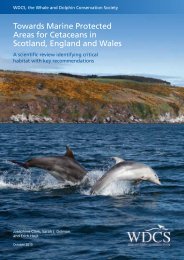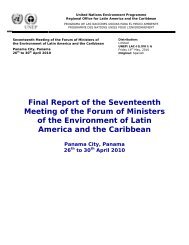Sea Turtle Recovery Action Plan for Barbados - WIDECAST
Sea Turtle Recovery Action Plan for Barbados - WIDECAST
Sea Turtle Recovery Action Plan for Barbados - WIDECAST
Create successful ePaper yourself
Turn your PDF publications into a flip-book with our unique Google optimized e-Paper software.
CEP Technical Report No. 12<br />
IV. SOLUTIONS TO STRESSES ON SEA TURTLES IN BARBADOS<br />
4.1 Manage and Protect Habitat<br />
The protection of important <strong>for</strong>aging and nesting habitats is crucial to the survival of sea<br />
turtles in <strong>Barbados</strong>. As is true <strong>for</strong> many territories in the Caribbean, the decline in sea turtle<br />
stocks in <strong>Barbados</strong> has coincided with a decline in nearshore fishery resources in general,<br />
including lobster, conch, and sea eggs, and chronic deterioration of marine and coastal<br />
environments. Nearshore fisheries are both easily accessible, and so the first to be overexploited,<br />
and are the most vulnerable to land-based sources of pollution (see sections 4.143, 4.146, 4.147).<br />
Where the pollution of nearshore waters negatively impacts on coral reef health, the<br />
effectiveness of reefs as dissipators of wave energy is diminished and beach erosion can follow.<br />
There<strong>for</strong>e, nearshore habitat deterioration will ultimately affect more than just the livelihoods of<br />
fishermen. The island's economy is heavily dependent upon tourism, and the management and<br />
protection of natural resources is beginning to receive high priority (sections 4.611, 4.612). <strong>Sea</strong><br />
turtles are <strong>for</strong>tunate in that they should also benefit from most management and protection plans<br />
designed to mitigate the many threats posed by pollution and general neglect of the marine<br />
environment.<br />
4.11 Identify essential habitat<br />
In <strong>Barbados</strong>, coral reefs and sea grass beds are utilized by sea turtles <strong>for</strong> <strong>for</strong>aging and<br />
sandy beaches are utilized <strong>for</strong> nesting. Primary habitats are poorly known, although some survey<br />
work has been undertaken. There are no marine or terrestrial parks or reserves designated <strong>for</strong> the<br />
protection of sea turtles. However, turtles and other marine life are protected from pollution and<br />
harvest within the confines of the <strong>Barbados</strong> Marine Reserve, which extends 2.2 km along the<br />
west coast and 1000 m offshore (Map 5).<br />
4.111 Survey <strong>for</strong>aging areas<br />
Limited resources dictate that the management and conservation of sea turtles focus first<br />
on those habitats most critical to their survival in <strong>Barbados</strong>; further study is sorely needed in<br />
order to identify these areas. The Coastal Conservation Study (1984) mapped the locations of<br />
sea grass beds and coral reefs around the west and south beaches of <strong>Barbados</strong> (Map 2). These<br />
areas all represent potential <strong>for</strong>aging habitats <strong>for</strong> green and hawksbill sea turtles. Loggerheads,<br />
which are rare in <strong>Barbados</strong>, would be expected to <strong>for</strong>age on crustaceans and mollusks in reef,<br />
rock and other hard bottom areas. Leatherbacks have not been observed to feed in the waters of<br />
<strong>Barbados</strong>, and apparently remain in deep waters between nestings. This species would be<br />
expected to consume jellyfish and related animals either at the surface or in the water column.<br />
Foraging has been cited as an impetus <strong>for</strong> deep diving by gravid females in the U. S. Virgin<br />
Islands (Eckert et al., 1989).<br />
<strong>Sea</strong> grasses are much less extensive around <strong>Barbados</strong> than around most other Caribbean<br />
islands and their role in the coastal ecosystem of <strong>Barbados</strong> has not been studied. The largest<br />
grass bed areas are on the south coast from Oistins to Bridgetown, and there are smaller beds in<br />
protected bays on the east coast. Along the western coast, sea grasses are very sparse. Knowled-<br />
Page 10

















